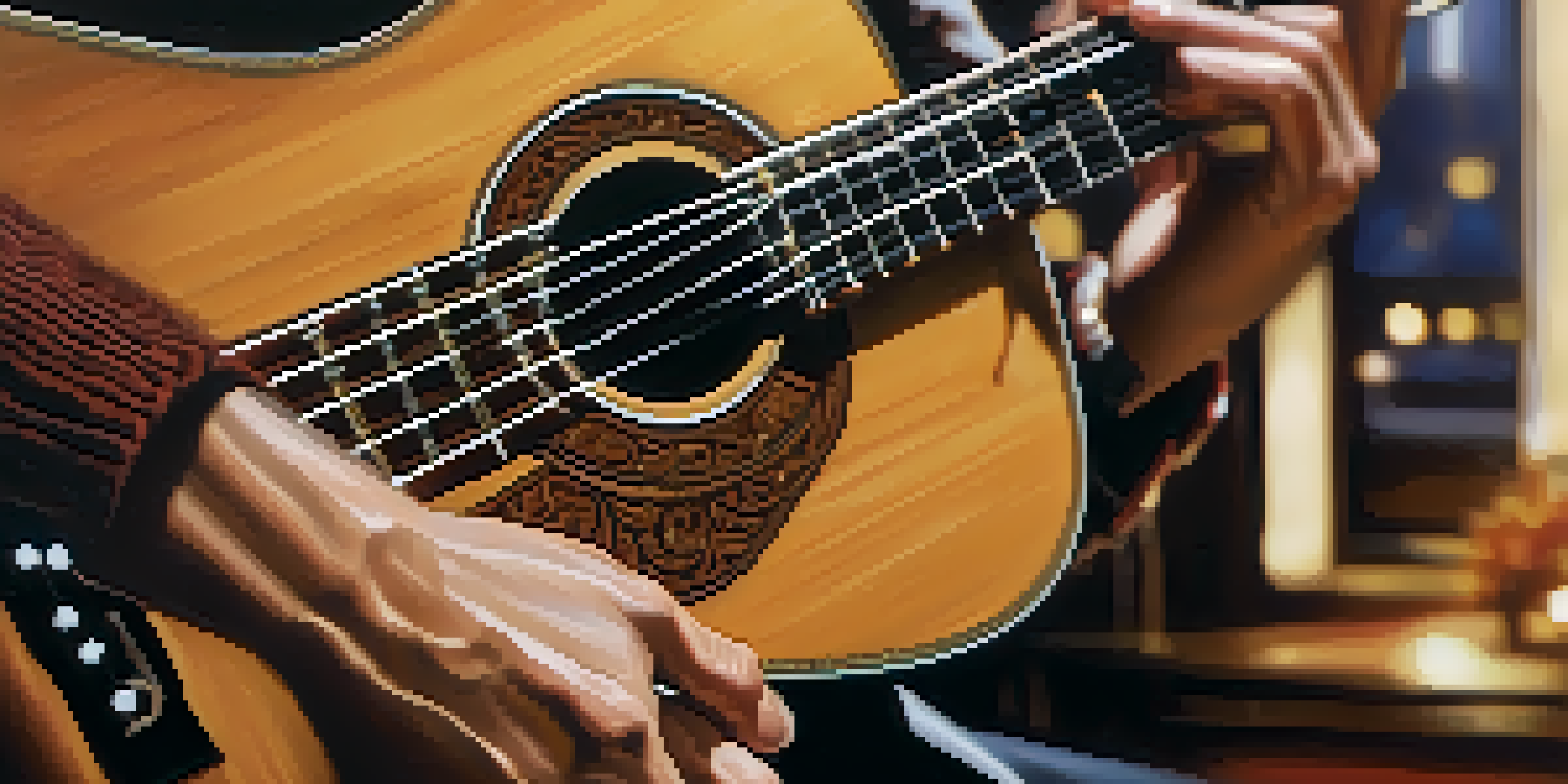Mastering Basic Strumming Patterns for Rhythm Guitar Playing

Understanding the Importance of Strumming Patterns
Strumming patterns are the heartbeat of rhythm guitar playing. They provide the essential groove that drives a song forward, making them crucial for both the player and the listener. Mastering basic patterns can elevate your playing, allowing you to accompany singers or fellow musicians more effectively.
The music is not in the notes, but in the silence between them.
Think of strumming patterns as the framework of a house; without a solid structure, everything else falls apart. When you grasp these patterns, you can easily adapt to different music genres, from folk to rock to pop. This adaptability not only enhances your versatility as a guitarist but also makes playing with others more enjoyable.
Moreover, learning strumming patterns helps build your timing and rhythm. Good rhythm is like a dance; it keeps everything in sync and creates an engaging experience for everyone. The more you practice, the more natural it becomes, allowing you to focus on expressing yourself musically.
Getting Started: Counting and Timing Basics
Before diving into strumming patterns, it's essential to understand counting and timing. Most music is based on a 4/4 time signature, which means there are four beats in each measure. This fundamental knowledge will help you stay on track as you practice your strumming.

To make counting easier, try clapping along to your favorite songs. This simple exercise helps you internalize the beat, making it easier to translate that feeling to your guitar. Once you can clap the rhythm, you’ll find it much simpler to strum along.
Strumming Patterns Shape Music
Strumming patterns are essential for creating rhythm and enhancing musical expression in guitar playing.
Using a metronome can also be beneficial for developing your timing. Start slow, and as you become more comfortable, gradually increase the speed. This practice not only improves your rhythm but also builds your confidence as a guitarist.
Exploring Common Strumming Patterns
Now that you understand counting, let’s explore some common strumming patterns. One of the most basic is the down-up (D-U) strum, where you strum down on the beats and up on the offbeats. This pattern is versatile and forms the foundation for many songs.
Music can change the world because it can change people.
Another popular pattern is the down-down-up-up-down-up (D-D-U-U-D-U) strum. This one adds a little more flair and can be heard in countless tunes. Practicing this pattern will not only improve your strumming skills but also familiarize you with the feel of different rhythms.
As you become more comfortable with these patterns, try combining them. Mix and match to create a unique sound or to fit the style of a specific song. The possibilities are endless, and experimenting will help you discover your personal strumming style.
Using Dynamics in Your Strumming
Strumming isn’t just about hitting the strings; it’s about how you hit them. Dynamics—the variation in loudness or intensity—can bring your playing to life. By varying your strumming strength, you can create a more engaging performance.
For instance, playing softly during verses and strumming harder during choruses can add emotional depth to your music. This technique allows you to build tension and release it, making your playing more expressive. Think of it like a conversation; sometimes you whisper, and other times you raise your voice to emphasize a point.
Master Timing with Counting Basics
Understanding counting and timing is crucial for staying in sync while practicing strumming patterns.
To practice dynamics, try playing the same strumming pattern at different volumes. Notice how it changes the feel of the music. This awareness will help you become a more dynamic player, enhancing your overall sound.
Practicing with a Metronome or Backing Track
Consistency is key to mastering strumming patterns, and practicing with a metronome can help you achieve that. A metronome provides a steady beat, allowing you to focus on your timing and rhythm. Start slow to ensure accuracy before gradually increasing the tempo.
Alternatively, using backing tracks can make practice more enjoyable. These tracks simulate playing with a band, giving you a sense of how your strumming fits into a full musical context. It's like having a jam session right in your living room!
As you practice, pay attention to how your strumming interacts with the rhythm of the backing track. This awareness will help you develop a stronger sense of timing and improve your overall musicianship.
Applying Strumming Patterns to Your Favorite Songs
A fantastic way to put your strumming skills into practice is by applying them to your favorite songs. Many popular songs use simple strumming patterns, making them perfect for beginners. Start by identifying the chords and the strumming pattern used in the song.
Once you’ve chosen a song, break it down into sections. Focus on mastering one part at a time—like the verse or the chorus—before putting it all together. This method allows you to build confidence and ensures you’re not overwhelmed.
Explore Advanced Strumming Techniques
Building on basic patterns by incorporating dynamics and syncopation can elevate your strumming skills and musical creativity.
As you play along, pay attention to how the strumming pattern enhances the song. This connection between your playing and the music will inspire you and motivate you to keep improving.
Expanding Your Strumming Skills: Advanced Patterns
Once you’ve mastered the basics, consider exploring more advanced strumming patterns. These patterns often incorporate syncopation—where the emphasis is placed on unexpected beats. This adds complexity to your playing and can make even simple songs sound more interesting.
An example of an advanced pattern is the down-up-chuck (D-U-C) strum, where you create a muted 'chucking' sound by lightly resting your palm on the strings. This technique adds a rhythmic flair and can be found in many popular genres, including reggae and funk.

As you practice these advanced patterns, remember that the goal is to enhance your musical expression. Don’t be afraid to experiment and find what feels right for you. The more you explore, the more unique your style will become.